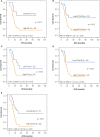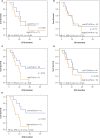Improved risk stratification by PET-based intratumor heterogeneity in children with high-risk neuroblastoma
- PMID: 36353561
- PMCID: PMC9637983
- DOI: 10.3389/fonc.2022.896593
Improved risk stratification by PET-based intratumor heterogeneity in children with high-risk neuroblastoma
Abstract
Purpose: The substratification of high-risk neuroblastoma is challenging, and new predictive imaging biomarkers are warranted for better patient selection. The aim of the study was to evaluate the prognostic role of PET-based intratumor heterogeneity and its potential ability to improve risk stratification in neuroblastoma.
Methods: Pretreatment 18F-FDG PET/CT scans from 112 consecutive children with newly diagnosed neuroblastoma were retrospectively analyzed. The primary tumor was segmented in the PET images. SUVs, volumetric parameters including metabolic tumor volume (MTV) and total lesion glycolysis (TLG), and texture features were extracted. After the exclusion of imaging features with poor and moderate reproducibility, the relationships between the imaging indices and clinicopathological factors, as well as event-free survival (EFS), were assessed.
Results: The median follow-up duration was 33 months. Multivariate analysis showed that PET-based intratumor heterogeneity outperformed clinicopathological features, including age, stage, and MYCN, and remained the most robust independent predictor for EFS [training set, hazard ratio (HR): 6.4, 95% CI: 3.1-13.2, p < 0.001; test set, HR: 5.0, 95% CI: 1.8-13.6, p = 0.002]. Within the clinical high-risk group, patients with a high metabolic heterogeneity showed significantly poorer outcomes (HR: 3.3, 95% CI: 1.6-6.8, p = 0.002 in the training set; HR: 4.4, 95% CI: 1.5-12.9, p = 0.008 in the test set) compared to those with relatively homogeneous tumors. Furthermore, intratumor heterogeneity outran the volumetric indices (MTVs and TLGs) and yielded the best performance of distinguishing high-risk patients with different outcomes with a 3-year EFS of 6% vs. 47% (p = 0.001) in the training set and 9% vs. 51% (p = 0.004) in the test set.
Conclusion: PET-based intratumor heterogeneity was a strong independent prognostic factor in neuroblastoma. In the clinical high-risk group, intratumor heterogeneity further stratified patients with distinct outcomes.
Keywords: 18F-FDG; PET/CT; intratumor heterogeneity; neuroblastoma; pediatric; radiomics.
Copyright © 2022 Li, Wang, Li, Yin, Feng, Fu, Wang and Chen.
Conflict of interest statement
The authors declare that the research was conducted in the absence of any commercial or financial relationships that could be construed as a potential conflict of interest.
Figures






Similar articles
-
Risk Stratification of Pediatric Patients With Neuroblastoma Using Volumetric Parameters of 18F-FDG and 18F-DOPA PET/CT.Clin Nucl Med. 2017 Mar;42(3):e142-e148. doi: 10.1097/RLU.0000000000001529. Clin Nucl Med. 2017. PMID: 28072621
-
The prognostic value of 18F-FDG PET/CT intra-tumoural metabolic heterogeneity in pretreatment neuroblastoma patients.Cancer Imaging. 2022 Jul 5;22(1):32. doi: 10.1186/s40644-022-00472-4. Cancer Imaging. 2022. PMID: 35791003 Free PMC article.
-
Prognostic value of metabolic indices and bone marrow uptake pattern on preoperative 18F-FDG PET/CT in pediatric patients with neuroblastoma.Eur J Nucl Med Mol Imaging. 2018 Feb;45(2):306-315. doi: 10.1007/s00259-017-3851-9. Epub 2017 Nov 7. Eur J Nucl Med Mol Imaging. 2018. PMID: 29110068
-
Prognostic Value of Volume-Based Metabolic Parameters of 18F-FDG PET/CT in Uterine Cervical Cancer: A Systematic Review and Meta-Analysis.AJR Am J Roentgenol. 2018 Nov;211(5):1112-1121. doi: 10.2214/AJR.18.19734. Epub 2018 Sep 12. AJR Am J Roentgenol. 2018. PMID: 30207790
-
Prognostic value of pretreatment 18F-FDG PET-CT for nasopharyngeal carcinoma patients.Medicine (Baltimore). 2017 Apr;96(17):e6721. doi: 10.1097/MD.0000000000006721. Medicine (Baltimore). 2017. PMID: 28445287 Free PMC article. Review.
Cited by
-
A narrative review of radiomics and deep learning advances in neuroblastoma: updates and challenges.Pediatr Radiol. 2023 Dec;53(13):2742-2755. doi: 10.1007/s00247-023-05792-6. Epub 2023 Nov 10. Pediatr Radiol. 2023. PMID: 37945937 Review.
-
Whole-tumoral metabolic heterogeneity in 18F-FDG PET/CT is a novel prognostic marker for neuroblastoma.Cancer Imaging. 2024 Jun 11;24(1):72. doi: 10.1186/s40644-024-00718-3. Cancer Imaging. 2024. PMID: 38863073 Free PMC article.
-
Neuroblastoma with high ASPM reveals pronounced heterogeneity and poor prognosis.BMC Cancer. 2024 Sep 17;24(1):1151. doi: 10.1186/s12885-024-12912-4. BMC Cancer. 2024. PMID: 39289658 Free PMC article.
-
The prognostic role of 18F-FDG PET/CT-based response evaluation in children with stage 4 neuroblastoma.Eur Radiol. 2024 Nov;34(11):7125-7135. doi: 10.1007/s00330-024-10781-w. Epub 2024 May 17. Eur Radiol. 2024. PMID: 38758254
-
The regulatory roles and clinical significance of glycolysis in tumor.Cancer Commun (Lond). 2024 Jul;44(7):761-786. doi: 10.1002/cac2.12549. Epub 2024 Jun 8. Cancer Commun (Lond). 2024. PMID: 38851859 Free PMC article. Review.
References
LinkOut - more resources
Full Text Sources

